The 1993 Brazilian Grand Prix
Usually the Brazilian Grand Prix isn't one with too much to remember. With the race always being early in the season, most teams have yet to develop their cars to their full potential, resulting in everyone being rather careful not to break too much. The 70s showed much domination by Carlos Reutemann and Emerson Fittipaldi and 1991 of course brings the story of Ayrton Senna's first home victory with a start to finish domination in a partially wet race.
 However, his second victory on home soil, again partially in the wet, might be the sweeter one of the two. While Senna didn't dominate like in 1991, this victory was achieved with a McLaren which that inferior to the Williams in all aspects.
However, his second victory on home soil, again partially in the wet, might be the sweeter one of the two. While Senna didn't dominate like in 1991, this victory was achieved with a McLaren which that inferior to the Williams in all aspects.
The season had just started in South Africa, where Alain Prost outclassed the entire field and showed he was back after his sabbatical year. The Frenchman lapped the field with the exception of his arch-rival Ayrton Senna, who finished over a minute behind. With six different teams in the points, everything behind Williams was very much open. In this respect the Brazilian Grand Prix could prove vital in setting the pace of the championship.
Looking back, this is a race which played a key part in several aspects of the season. It helped Ayrton Senna in becoming second in the championship in an inferior car, it helped Michael Andretti on his way out of Formula One and back to the Indycars and it showed the final antics of a once heroic team, Lotus. Therefore, for many varied reasons, this is a race to remember.
Before the Race
 First practice already showed the current state of affairs. Both Williams were well ahead of the pack, with Alain Prost leading Damon Hill. Behind them came two surprises: Austrian Karl Wendlinger set an impressive third time in the Sauber, while Ligier driver Erik Comas steered his car to fourth, just before Ayrton Senna's McLaren. With respectively 1:18.4 and 1:18.6 for the Williams drivers and 1:19.8 for Wendlinger, the gap was already big, before the actual qualifying started.
First practice already showed the current state of affairs. Both Williams were well ahead of the pack, with Alain Prost leading Damon Hill. Behind them came two surprises: Austrian Karl Wendlinger set an impressive third time in the Sauber, while Ligier driver Erik Comas steered his car to fourth, just before Ayrton Senna's McLaren. With respectively 1:18.4 and 1:18.6 for the Williams drivers and 1:19.8 for Wendlinger, the gap was already big, before the actual qualifying started.
The first qualifying session on Friday added to the worries of the other teams. Both Prost and Hill were seemingly in a different class altogether, with the Frenchman now also striking a gap to his teammate. Prost, usually not the one to drive faster than strictly necessary, crossed the line in 1:16.809. This left Damon Hill a full second behind and Prost's arch-rival Ayrton Senna a big 1.8 seconds behind in third. Of the first practice surprises, Wendlinger was able to stay in the top with a fifth provisional place on the grid.
 In the second qualifying session Damon Hill got his act pretty much together, setting a time just 0.05 seconds slower than Prost's time the day before. However, the Frenchman pulled out a stunning performance, improving yet another full second to claim Pole Position. The second row was formed by Ayrton Senna and Benetton driver Michael Schumacher, 1.8 seconds behind the Frenchman, just as the situation on Friday had been.
In the second qualifying session Damon Hill got his act pretty much together, setting a time just 0.05 seconds slower than Prost's time the day before. However, the Frenchman pulled out a stunning performance, improving yet another full second to claim Pole Position. The second row was formed by Ayrton Senna and Benetton driver Michael Schumacher, 1.8 seconds behind the Frenchman, just as the situation on Friday had been.
Behind the German was Senna's teammate Michael Andretti, who qualified in some sort of a void, having a gap of 0.8 seconds to the front and 0.4 seconds behind him. Behind Andretti was Schumacher's teammate Riccardo Patrese, who came back from a weak 13th position after first qualifying. Both Ferraris were hugely disappointing, with Jean Alesi qualifying ninth, while Gerhard Berger has to start the race from 13th after crashing his car when the active suspension collapsed. Jordan's Ivan Capelli never got close to the tenth place he got in the first timed session on Friday; almost six seconds behind Prost, the unfortunate Italian didn't qualify for the race.
The Race
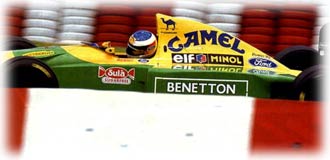 The action began right after the cars had started leaving the grid. In the front everything went as usual, Alain Prost making a good start from pole, while Ayrton Senna passed Damon Hill for second. Behind them, however, things went crazy in the first corner. Rookie Michael Andretti, regarded as a very talented Indycar driver, steered his McLaren into Ferrari driver Gerhard Berger, who had a brilliant start, passing half the field before the first corner. The cars' wheels kept both cars together as they stumbled towards the stands, only to stop just in front of the photographers. Needless to say that this was the end for the both of them. However, one Ferrari's misery proved to be the other's luck. Out of the dust came Jean Alesi in third after a magnificent start from ninth. Beside Andretti and Berger, also Martin Brundle in the Ligier and Fabrizio Barbazza (Minardi) didn't survive the first lap.
The action began right after the cars had started leaving the grid. In the front everything went as usual, Alain Prost making a good start from pole, while Ayrton Senna passed Damon Hill for second. Behind them, however, things went crazy in the first corner. Rookie Michael Andretti, regarded as a very talented Indycar driver, steered his McLaren into Ferrari driver Gerhard Berger, who had a brilliant start, passing half the field before the first corner. The cars' wheels kept both cars together as they stumbled towards the stands, only to stop just in front of the photographers. Needless to say that this was the end for the both of them. However, one Ferrari's misery proved to be the other's luck. Out of the dust came Jean Alesi in third after a magnificent start from ninth. Beside Andretti and Berger, also Martin Brundle in the Ligier and Fabrizio Barbazza (Minardi) didn't survive the first lap.
One lap later Michael Schumacher overtook Jean Alesi for fourth place, taking back his grid position. The race then settled down, as Alain Prost slowly drove away from the following cars of Senna and Hill. The fifth car to leave the race prematurely was Schumacher's teammate Riccardo Patrese, whose suspension failed after only three laps. After just two races, the talk was that the Italian marathon man would be sacked. With a late spin in South Africa, the early exit at Interlagos and qualifying results far behind Schumacher, Patrese didn't seem to fit into Benetton's plans anymore. However, no such thing happened and eventually he completed the season and retired after 256 Grands Prix.
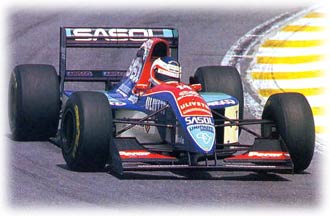 In his Ford powered McLaren, Ayrton Senna wasn't able to keep the pace with the Williams, resulting in Damon Hill moving to second after ten laps, much to the dismay of the crowd. The next drama came when young local Rubens Barrichello abandoned the race after 13 laps with a broken gearbox. Although not as popular as Ayrton Senna, Barrichello was, like his friend and mentor, a local at Interlagos. After another 12 laps, Ayrton Senna also had to give way to Michael Schumacher.
In his Ford powered McLaren, Ayrton Senna wasn't able to keep the pace with the Williams, resulting in Damon Hill moving to second after ten laps, much to the dismay of the crowd. The next drama came when young local Rubens Barrichello abandoned the race after 13 laps with a broken gearbox. Although not as popular as Ayrton Senna, Barrichello was, like his friend and mentor, a local at Interlagos. After another 12 laps, Ayrton Senna also had to give way to Michael Schumacher.
Then came the rain. A rainstorm of tropical proportions quite suddenly raged across the track, making the cars rather undrivable. The first victims of the rain were the two Japanese drivers. First Aguri Suzuki's Footwork spun off, while a couple of seconds later the Tyrrell of Ukyo Katayama, already a lap behind, suffered the same fate. Before the organisers could react, another two cars fell victim to the water. First it was another Brazilian, as Christian Fittipaldi spun his Minardi. The oncoming race leader Alain Prost, ready to lap the Brazilian, didn't see the Minardi coming to a halt and crashed into it, ending the Frenchman's race.
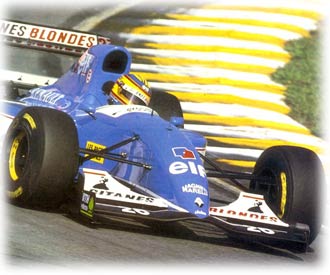 At this point, after 29 laps, the safety car came out on track. Until lap 38, when the rain finally weakened enough to make the track driveable again, the safety car stayed in front of the pack, in the process taking away the gap Damon Hill and Michael Schumacher had built over Ayrton Senna.
At this point, after 29 laps, the safety car came out on track. Until lap 38, when the rain finally weakened enough to make the track driveable again, the safety car stayed in front of the pack, in the process taking away the gap Damon Hill and Michael Schumacher had built over Ayrton Senna.
When the safety car left the track, the action started again. Jean Alesi proved yet again what a brilliant starter he was, by moving past Senna and Schumacher to second place behind Damon Hill. Another sharp starter was Johnny Herbert, who moved from eighth to fifth on the track that throughout the years has seen some of his best action.
Hill built a small lead, but the safety car situation had turned a seemingly hopeless situation for Ayrton Senna into a good chance to win his home Grand Prix for the second time. This unleashed the Brazilian and before you knew it, he passed the Hill and quickly didn't have a thing to worry about. Meanwhile both Schumacher and Alesi dropped far back due to pitstops, causing Johnny Herbert in his Lotus to move up to third. In the days of a rapidly fading Lotus team, this was as spectacular as an Arrows driving to a podium position these days.
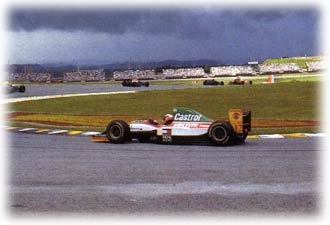 While Senna built his lead and Schumacher moved back up through the field, the race went into a status quo for the remainder of the race, most drivers having had their share of action for the day. Sadly for Lotus and Herbert, Schumacher's rise robbed them of their podium finish a mere two laps from the end. In the end Ayrton Senna celebrated his second win in Brazil and also McLaren's 100th Grand Prix victory. Damon Hill crossed the line almost 17 seconds behind the victor, while Schumacher only a second ahead of Herbert in third. Behind them followed Mark Blundell, who surprisingly finished in the points for the second time in as many races. In sixth finished the second Lotus driver, Alessandro Zanardi, scoring the only point of his Formula One career. This was the last time both Lotus' were in the points. After this, only Johnny Herbert would score two more fourth places and a fifth, before Lotus called it a day.
While Senna built his lead and Schumacher moved back up through the field, the race went into a status quo for the remainder of the race, most drivers having had their share of action for the day. Sadly for Lotus and Herbert, Schumacher's rise robbed them of their podium finish a mere two laps from the end. In the end Ayrton Senna celebrated his second win in Brazil and also McLaren's 100th Grand Prix victory. Damon Hill crossed the line almost 17 seconds behind the victor, while Schumacher only a second ahead of Herbert in third. Behind them followed Mark Blundell, who surprisingly finished in the points for the second time in as many races. In sixth finished the second Lotus driver, Alessandro Zanardi, scoring the only point of his Formula One career. This was the last time both Lotus' were in the points. After this, only Johnny Herbert would score two more fourth places and a fifth, before Lotus called it a day.
Conclusion
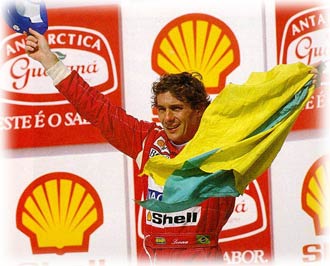 While this race may not have been all thrills from start to finish, it certainly gave some things to remember. Ayrton Senna outclassed Damon Hill in the second part of the race in a car that was much less powerful than the Williams, which in turn might have been one of the strongest Grand Prix cars ever to hit the track. Of course McLaren's 100th victory was also a fact of historic proportions, having some extra value because it was with such an inferior car.
While this race may not have been all thrills from start to finish, it certainly gave some things to remember. Ayrton Senna outclassed Damon Hill in the second part of the race in a car that was much less powerful than the Williams, which in turn might have been one of the strongest Grand Prix cars ever to hit the track. Of course McLaren's 100th victory was also a fact of historic proportions, having some extra value because it was with such an inferior car.
This race also showed two extreme sides of Alain Prost, which were both rare, let alone them being in a single race weekend. First we saw the Frenchman displaying complete dominance in all sessions with gaps, even towards his teammate in the same car, that were unheard of for the Professor. In the end we saw him leave the track in an even rarer mistake. Of course the question remains of whether the safety car shouldn't have been brought out before Prost crashed out. All in all, a spectacular water ballet, which is well worth remembering.

